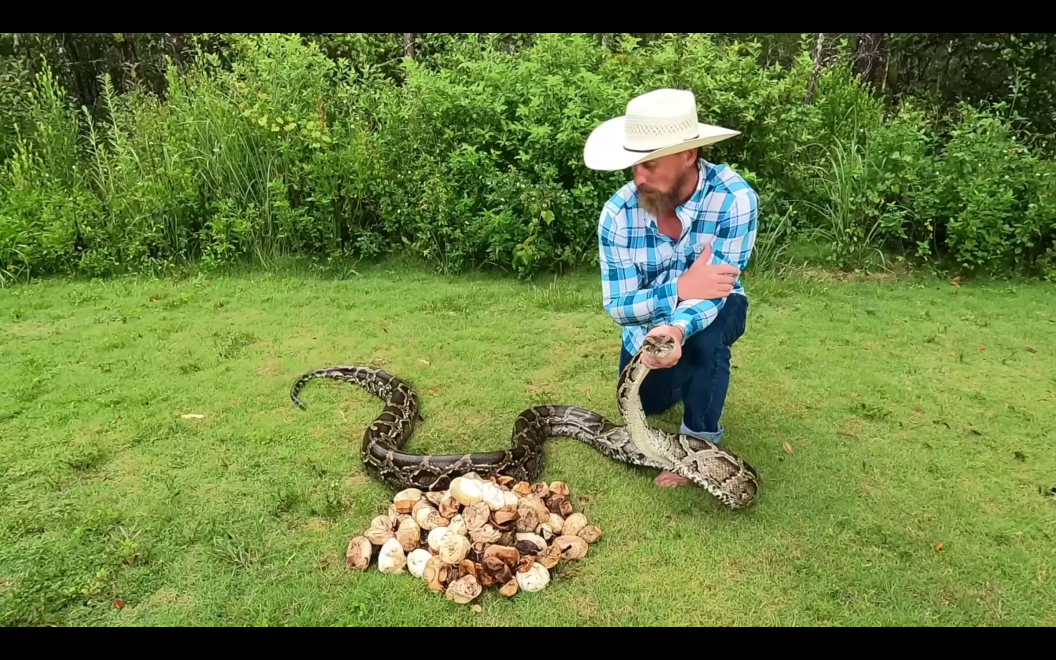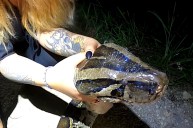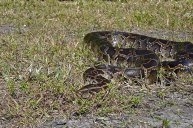A new record was set in Florida with the capture of a live Burmese python, but not for a length or weight record (although the longest python was also captured this week—by a college student and his friends!). Instead, this female python had laid a record-breaking eggs in her nest—111 total.
Brandon Rahe, a contractor for the Florida Fish and Wildlife Conservation Commission (FWC), was out python hunting, working to help manage the out-of-control invasive population of the large snakes.
In a video he later uploaded, Rahe discovers a nest hidden amidst the tall grasses—a location extremely easy to overlook if you didn't know what you were looking for. There are signs of the tall grass being pushed over and of entryways into the snake's den.
READ MORE: Massive Python Nest With 93 Eggs Found In Florida — What Does That Mean for the Wildlife?
As Rahe cuts and pulls grasses away to get a better look inside the den, he spots mom, laying over her eggs. Barehanded, he coaxes her out, and you can see her lunge at him before he grabs her by the neck and pulls her out.
His excitement radiates as you hear him and his cameraman make exclamations about how big she is. As Rahe pulls, snake comes out and keeps coming, and coming, and coming.
In the video, Rahe and another person do a preliminary measurement of the snake that they state comes out to 14 feet, 2 inches. An expert with the FWC reported the snake measured 13 feet, 9 inches. Either way, this girl was long, and not a snake you'd want to wrestle with (especially after seeing the close up of her sharp teeth in this video-ouch).
But in the end, it was her brood that was really worth noting: Her hidden cove housed 111 eggs in the final count, including partial egg casings and the eggs this gal was still laying as she got captured.
Burmese Python Facts
These snakes are native to the jungles and grassy marshes of Southeast Asia. Burmese pythons are among the largest snakes in the world, and can reach lengths of 23 feet. Another record was recently broken when the longest Burmese python ever captured in Florida was recorded at 19 feet-as long as a giraffe is tall, for some perspective.
These monstrously large snakes are constrictors, meaning they have a scary combination of snake features; while they aren't a venomous species, they do have sharp teeth and will lunge at prey to bite and subdue their victims. Burmese pythons are constrictors though, so after their bite, they tighten around and suffocate their prey before swallowing them.
Their massive size means they can take on extremely large animals as prey. Some of the stomach contents identified in Burmese pythons are white-tailed deer hooves and even a 5-foot long alligator.
According to National Geographic, these snakes are often a top choice in the exotic pet trade due to their beautiful patterns, typically docile nature, and rapid reproduction rate. Their desirability as pets in addition to declining habitat and other factors have landed them on the threatened species list worldwide, though their populations are thriving in Florida.
Why Are Burmese Pythons Bad?
As is true with most wild and exotic animals, these generally gentle giants are often poorly cared for and released into the wild, which is likely how they ended up in the Everglades in Florida, where they are an invasive species.
Being a nonnative species in Florida, these snakes don't encounter natural predators, which leaves them rampantly ravaging native species. Dozens of species of mammals, birds, and reptiles have been found in necropsies of these pythons. There has been significant decline in several species in the southernmost regions of Everglades National Park, including statistics as shocking as raccoon populations dropping 99.3% and opossum populations declining 98.9%. These reductions are linked to the flourishing populations of Burmese pythons.
This invasive reptile is doing so well that there is even the Florida Python Challenge, where people compete for ten days to remove as many of them as possible. The grand prize for this competition is $10,000, with a second place prize and other prizes available as well.
While this challenge is helpful in encouraging conservations to actively participate in snake removal, the FWC shares that removal of the invasive Burmese python is encouraged year round. These snakes are protected only by cruelty law, and can be humanely killed without a hunting license or permit on private property with landowner permission, as well as on 32 Commission-managed lands in south Florida year round. Since 2000, over 17,000 of these big guys have been removed from Florida.
What Will Happen to Momma Python?
Rahe shares in his video that she will become a "scout snake." She will have a GPS tracker implanted and then be released back into the wild in Florida.
After the hard work of searching to find her, this may seem disappointing to some of those looking to reduce Burmese python populations in the Everglades. But this release and tracking will help provide information about these snakes' habits and let us know more about how they move around, hopefully making it easier to manage their populations moving forward.
READ MORE: Rats Are Flourishing in Florida Thanks to Invasive Pythons, New Study Says




